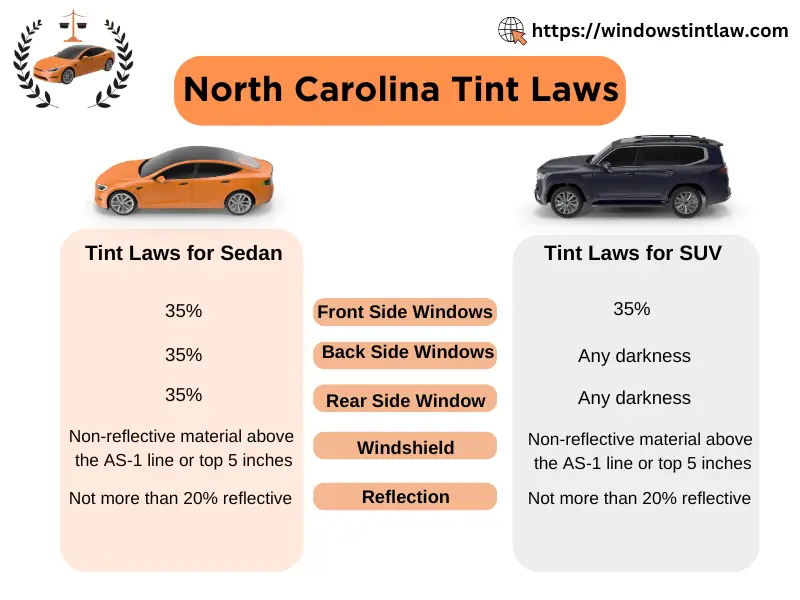North Carolina Tint laws were legislated in 2001 which permit drivers and vehicle owner to tint windows within allowed limits.
Window tinting laws of North Carolina allows 35% Visible Light Transmission through vehicle windows with a deviation of 3 percent. Hence, All vehicles windows must pass 32% of the light through windows, otherwise the window tint shall be considered as illegal.
Tinted windows offer multiple benefits for motorists , Alternatively it can be problematic to apply illegal tint which obstructs the driver’s view may results in accidents and tint tickets shall be issued if cops caught such driver.
Check out the below section to find out in-depth details of tinting laws applicable in North Carolina.
Overview of North Carolina Tint Laws
The below image shows the window tint darkness and tint reflection limits for Cars and SUVs operated in North Carolina.

Darkest Legal Tint in North Carolina
The darkest legal tint percentages and Tint reflection for Sedan and SUV or multi purpose vehicles in North Carolina are mentioned in the below tables.
Window Tint Darkness For Sedan
| State | Front Side Windows | Back Side Windows | Rear Window | Windshield | Tint Reflection | Color Tints |
| North Carolina | 35% | 35% | 35% | Non reflective tint above the AS1 line or top 5 inches. | Not more than 20% reflective. | Red, Amber and Yellow Tint colors are restricted. |
Window Tint Darkness For SUV or Vans
| State | Front Side Windows | Back Side Windows | Rear Window | Windshield | Tint Reflection | Color Tints |
| North Carolina | 35% | Any | Any | Non reflective tint above the AS1 line or top 5 inches. | Not more than 20% reflective. | Red, Amber and Yellow Tint colors are restricted. |
Window Tint Reflection
According to North Carolina Tint laws, the light reflectance of the tinted windows must be 20% or less. The same rule is applicable for Sedan and SUV or Trucks.
| Window Tint Reflection Limits | Sedan | SUV or Trucks |
| Front Side Windows | Less than 20% reflective | Less than 20% reflective |
| Back Side Windows | Less than 20% reflective | Less than 20% reflective |
Moreover, Motorists are advised to install the appropriate type of window tint material which should not reflect light to a large extent. As the reflection from tinted windows may produce glare which cause discomfort for other drivers and passengers on roads.
Other Rules and Regulations
Some other rules are also applicable to vehicle operated in North Carolina:
- Dual Side Mirrors: Dual side mirrors are required if rear window or rear windshield is tinted.
- Restricted Tint Colors: Red, Yellow and Amber Tint colors are not allowed.
- Certificates: Window Film Manufacturer are not required to get certification for the tinting material they sell in state.
- Stickers: Sticker or Label to identify the legal tint is not required to display on windows.
Medical Exemptions
Any person with a certain medical condition can obtain the Medical Exemption or tint waiver from DMV North Carolina. Applicant is required to fill the Tint waiver application form signed and stamped by the licensed physician. The application shall be reviewed by Drivers Medical Evaluation program.
Tint waiver permit is valid up to Five years and any individual may not have two tint waivers at the same time. Also, Tint waiver certificates are not interchangeable and must be kept in the Vehicle.
Addition to above, Sticker to identify tint waiver is required to display on the lower left corner of the rear windshield. If the sticker is not displayed, driver can get a fine of $200.
Penalties for Violating Tint Laws
Any person who does not follow the tinting rules of North Carolina shall be guilty of Class 3 Misdemeanor.
